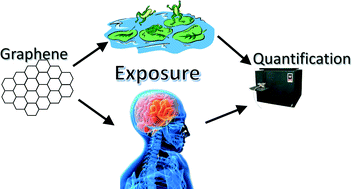Quantification of graphene and graphene oxide in complex organic matrices†
Abstract
Interest is growing for graphene as a nanomaterial for electronic and composite applications. Increased production and use of graphene warrants development of strategies to detect and monitor its effect on human health and the environment. A quantification method using programmed thermal analysis (PTA) was developed for few-layer graphene (FLG) and graphene oxide (GO). FLG exhibited strong thermal stability, which allowed for easy detection in matrices consisting of thermally weaker background organic carbon. GO (50% oxygen content) exhibited a weaker thermal stability than FLG, making quantification more challenging in the presence of thermally similar background organic carbon. To resolve this, an in situ reduction method using a reducing agent (sodium borohydride) was developed to remove surface-bound oxygen from GO. This was used in combination with a digestate (SolvableTM) to create an optimized extraction method for recovering FLG and GO from complex organic matrices. FLG and GO will enter sewer systems due to their use by industry and in consumer products. We investigated the applicability of this method for quantifying FLG and GO in wastewater biomass because they are likely to accumulate in wastewater biosolids, as these are commonly the first exposure route for novel materials in the environment. Spiking 20 μg of FLG and GO into a 200 mg dried biomass L−1 wastewater solution resulted in recoveries of 52 ± 8% and 80 ± 6%, respectively. Results from this study can be applied to the development of extraction methods for graphene from similar complex organic matrices (e.g., lung tissue, in vitro/in vivo studies, algae, daphnia) to support a range of human and ecotoxicological studies.


 Please wait while we load your content...
Please wait while we load your content...